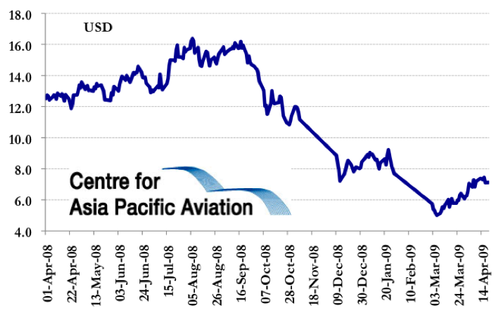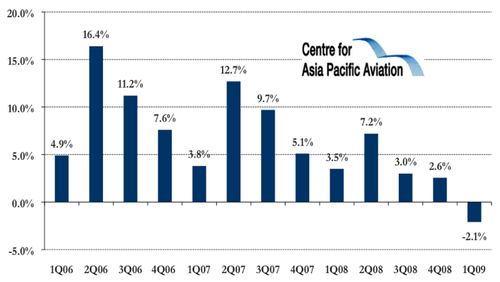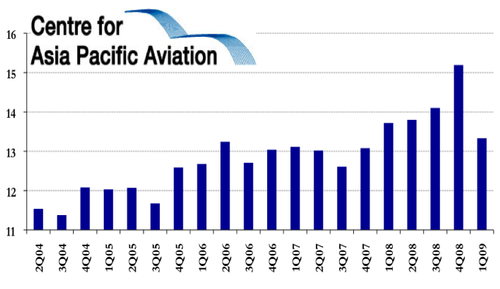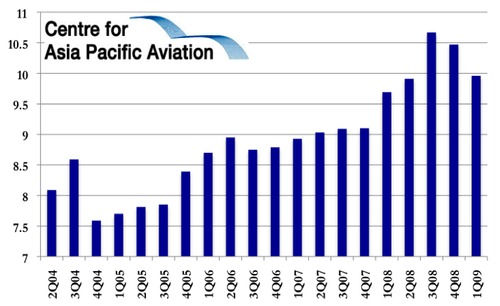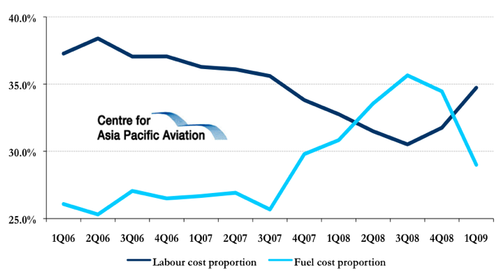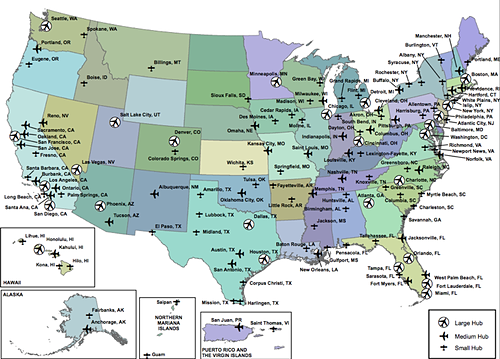Southwest Airlines: 2009 shaping up to be an extremely challenging year
Southwest reported a larger-than-expected quarterly loss of USD91 million in the first three months of 2009 (1Q09), a significant worsening from the USD34 million net profit reported in 1Q08, and the third consecutive quarter of net losses for the carrier, which had previously reported 17 years of net profitability.
The carrier, whose losses were negatively impacted by a reduction in fuel hedge values, a weak US economy and a rapid weakening in passenger demand, particularly among business travellers, stated it is currently facing "the toughest revenue environment" in its history, with CEO, Gary Kelly, warning, "we'll have to consider all available means to restore our profitability, or else we'll be bankrupt like so many other airlines have been".
Southwest financial highlights for three months ended 31-Dec-08
|
Currency: USD |
% Change |
|
|---|---|---|
|
Revenue (bill) |
2.4 |
-6.8% |
|
Operating costs (bill) |
2.4 |
-1.4% |
|
Operating profit (mill) |
-50 |
^ |
|
Net profit (loss) (mill) |
-91 |
~ |
|
Yield per RPM |
13.33 |
-2.8% |
|
Unit revenue per ASM (cents) |
9.75 |
-2.9% |
|
Unit costs per ASM (cents) |
9.96 |
+2.8% |
|
Unit costs per ASM (excluding fuel) (cents) |
7.07 |
+8.4% |
|
Traffic - revenue pax (mill) |
19.8 |
-8.1% |
|
Traffic RPMs (bill) |
16.9 |
-4.0% |
|
Capacity ASMs (bill) |
24.2 |
-4.1% |
|
Load factor (%) |
69.9% |
+0.1 ppts |
Southwest's loss took the market by surprise, prompting a 7.1% slump in the carrier's share price and resulting in several analysts immediately downgrading their ratings on the company, due to "likely continued declines in pricing and unit revenues" (S&P).
Southwest Airlines share price growth: Apr-2008 to Apr-2009
Losses "disappointing" but "not surprising"
However, according to CEO, Gary Kelly, the carrier's first quarter results, while "disappointing" were "not surprising given the current economic environment". He added, "a rapid weakening in passenger demand during first quarter, particularly among business travellers, led to our first quarter net loss. Although competitively strong and financially resilient, we are not immune to the challenges the worldwide recession is having on air travel".
Mr Kelly had previously warned that the current downturn could be worse than the 1991 downturn, stating, "I think we're all worried that this is sort of the 100-year flood in economic terms and that what we saw in 1991 is going to be worse this time. I think we all have to be prepared for a really tough environment and one that lasts for a long time."
First quarterly net loss excluding special items in 18 years; first operating loss in over three years
Southwest's 1Q09 loss was in large part due to special charges totalling USD71 million (net), relating to non-cash, mark-to-market and other items associated with a portion of the airline's fuel hedge portfolio.
Excluding special items, the carrier still reported a net loss of USD20 million, compared to a net profit of USD43 million in the previous corresponding period, and the first quarterly net loss excluding special items in 18 years.
Also in the quarter, Southwest reported its first operating loss in over three years, with an operating loss of USD50 million and an operating margin of -2.1%, compared to operating income of USD88 million and an operating profit margin of 3.5%, in 1Q08. Excluding special items, the carrier reported an operating profit of USD31 million, compared to a net profit of USD99 million for the same period in 2008.
Southwest operating margin: 1Q06 to 1Q09
The carrier's cash and cash equivalent's balance as at 31-Mar-09 was USD1.1 billion, a 16.2% reduction from 31-Dec-08 levels.
Yields and revenues feel the pinch, on "rapid weakening" in passenger demand; reductions set to continue
During 1Q09, Southwest's revenue also slipped, down 6.8% year-on-year to USD2.3 billion (comparatively, the LCC reported record quarterly revenue of USD2.7 billion in 4Q08). Freight revenue was the worst affected revenue area for the LCC, down 11.8% to USD30 million, while passenger revenue was down 6.7% to USD2.3 billion.
Passenger yields per RPM in 1Q09 worsened 2.8%, despite the average passenger fare increasing 1.5% to USD113.97, and as the average length of passenger haul increased 4.5% to 855 miles. Unit revenue (per ASM) also worsened, by 2.9% to USD 9.75 cents, as the number of full-fare passengers slipped 6.0 ppts to comprise 20% of total passenger numbers.
Southwest yield per RPM (US cents): 2Q04 to 1Q09
Southwest anticipates a year-on-year reduction in 2Q09 operating unit revenues, based on forward revenue and booking trends, and despite the benefits to be derived from the timing of the Easter holiday in Apr-2009.
Mr Kelly added that he "wouldn't be shocked at all" if Southwest's unit revenue falls more sharply in 2Q09 than the 2.9% year-on-year reduction in 1Q09 levels, as business travel softens significantly. He added that, based on past recessions, an increase in business travel will likely not occur "for quite some time".
On the cost side, operating costs were also down in 1Q09, by 1.4%, to USD2.4 billion. On a unit cost basis, Southwest reported an 8% year-on-year increase in unit costs (per ASM) to USD 9.96 cents, with non-fuel unit costs (per ASM) also on the rise, up 8.4% to USD 7.07 cents. Southwest expects 2Q09 unit costs, excluding fuel, to be in line with 1Q09 levels.
Southwest cost per ASM (US cents): 2Q04 to 4Q08
Shrinks for first time in 23 years in 1Q09; reductions to continue
In 1Q09, Southwest transported 19.8 million revenue passengers, an 8.1% year-on-year reduction (enplaned passengers fell 6.7% year-on-year to 23.0 million). Traffic (RPMs) was down 4.0% year-on-year, on a 4.1% capacity (ASM) reduction (ie the first time in Mr Kelly's 23 years at the carrier that Southwest has reduced capacity in any quarter), resulting in load factors increasing slightly, by 0.1 ppts, to a record first quarter load factor of 69.9%, even despite the impact of Easter shifting to April this year. Southwest accredits this improvement in load factors to the "success" of recent promotions and discounting activities (although this did have a negative impact on unit revenues and yields).
For FY2009, the LCC currently plans to reduce capacity by approximately 5% year-on-year, of which 4% was in place at Mar-2009. This contrasts to the 7.5% year-on-year capacity growth recorded during 2007 and the average annual 5.7% increase in capacity experienced between Dec-2006 and Dec-2008.
Southwest capacity (ASKs) growth: Jan-2004 to Mar-2009
Southwest, however, has considerable scope to soak up demand spilled by other carriers implementing deep domestic network cuts and to respond quickly to favourable market opportunities, with the carrier planning to implement strategic capacity increases in fast-growing markets with long-term potential (for example, Denver, Minneapolis-St Paul, Boston Logan and New York LaGuardia), while eliminating some less-profitable operations. Despite the overall capacity reductions, Southwest will still add the highest number of new cities to its network in a one-year period since 1999, through a rationalisation of its network, which involves cutting 190 flights in underperforming markets (see also below under 'A new network strategy and new complexities' sub-heading).
Southwest's current 2009 fleet plan includes taking delivery of 13 new B737-700 aircraft and retiring 15 aircraft by the end of the year, as set out in the carrier's Jan-2009 guidance.
Southwest fleet plan: 2009 to 2016: as at Mar-2009 (Sep-2008 plan in brackets)
|
Firm |
Options |
Purchase Rights |
Total |
|
|---|---|---|---|---|
|
2009 |
13 |
|
|
13 |
|
2010 |
10 (16) |
(6) |
|
10 (22) |
|
2011 |
10 (13) |
10 (19) |
|
20 (32) |
|
2012 |
13 |
10 (27) |
|
23 (40) |
|
2013 |
19 |
4 (1) |
|
23 (20) |
|
2014 |
13 (10) |
7 (8) |
|
20 (18) |
|
2015 |
14 (11) |
3 (6) |
|
17 |
|
2016 |
12 (4) |
11 (0) |
|
23 (4) |
|
2017-18 |
|
17 (0) |
54 |
71 (54) |
|
Total |
104 (99) |
62 (67) |
54 |
220 |
Fuel focus: Begins to rebuild hedging positions
Fuel and oil represented 29.0% of total operating expenses in the quarter (a reduction from the 3Q08 high of 35.7% and the 30.80% in 1Q08), resulting in labour costs once again being the carrier's largest cost item.
Southwest fuel and labour costs as a portion of total operating expenses: 1Q06 to 1Q09
Notably, Southwest confirmed that it has begun to rebuild its 2009 and 2010 hedge positions, after substantially reducing its fuel hedge position to approximately 10% of 2009-2013 requirements in 4Q08. The carrier has now increased this position and has derivative contracts in place for approximately 50% of 2Q09 estimated fuel consumption, approximately 40% for the remainder of 2009 and approximately 30% in 2010. The current market value (as of 14-Apr-09) of its net fuel derivative contracts for 2009 through 2013 reflects a net liability of approximately USD950 million.
Southwest Fuel Hedging Programme
|
Period |
% hedged: Sep-08 |
Price/barrel |
% hedged: Dec-08 |
% hedged: Mar-09 |
Price/barrel |
|---|---|---|---|---|---|
|
4Q06 |
Approx 85% |
USD43 |
Approx 85% |
Approx 85% |
USD43 |
|
4Q07 |
Approx 90% |
USD51 |
Approx 90% |
Approx 90% |
USD51 |
|
1Q08 |
Over 70% |
USD51 |
Over 70% |
Over 70% |
USD51 |
|
2Q08 |
Approx 70% |
USD51 |
Approx 70% |
Approx 70% |
USD51 |
|
3Q08 |
Approx 80% |
USD61 |
Approx 80% |
Approx 80% |
USD61 |
|
4Q08 |
Approx 85% |
USD62 |
Approx 85% |
Approx 85% |
USD62 |
|
2009 |
Over 75% |
USD73 |
Approx 10% |
Approx 50% |
USD73 |
|
2Q09 |
Approx |
n/a |
n/a |
Approx 50% |
USD66 |
|
2H09 |
n/a |
n/a |
n/a |
Approx 40% |
USD77 |
|
2010 |
Approx 50% |
USD90 |
Approx 10% |
Approx 30% |
USD77 |
|
2011 |
Approx 40% |
USD93 |
Approx 10% |
"Modest" position |
n/a |
|
2012 |
Over 35% |
USD90 |
Approx 10% |
"Modest" position |
n/a |
|
2013 |
n/a |
n/a |
Approx 10% |
"Modest" position |
n/a |
The carrier has also modified its major fuel hedge counterparty agreements to allow it to use collateral other than cash (eg using aircraft) to limit cash exposure. As of 14-Apr-09, Southwest had posted a total of USD425 million in cash collateral and approximately USD350 million in aircraft collateral to its fuel hedge counterparties. Based on its 2Q09 derivative position and market energy prices, Southwest currently anticipates 2Q09 economic jet fuel costs, including taxes, to be in line with 1Q09 at around the USD1.75/gallon range.
Labour focus: New labour agreements will limit international strategy evolution
As the airline cuts back on capacity, its plans to expand through codesharing have been delivered a blow by its pilots.
Like some others, Southwest announced plans to reduce staffing levels and costs, via a voluntary early-out programme, to help mitigate cost pressures in 2010.
The carrier has also reached a number of tentative agreements with its various unions. Most recently, Southwest and its pilots union reached a tentative contract agreement that includes pay raises and commits the company to future expansion.
Southwest recent labour agreements
|
Union |
Labour Group |
Date |
Details |
|---|---|---|---|
|
Southwest Airlines Pilot Association |
Pilots |
01-Apr-09 |
Reached a tentative contract agreement that includes pay raises and commits the company to expansion. |
|
Southwest Airlines Pilot Association |
Pilots |
30-Jan-09 |
Reached a tentative agreement in principle on a new, five-year agreement through 31-Aug-11. The agreement includes pay raises and increased retirement benefits, although no specific details were revealed. |
|
Aircraft Mechanics Fraternal Association |
Maintenance employees |
30-Jan-09 |
Voted to ratify the tentative, four-year agreement both parties reached in early Dec-2008. The new contract is active through 16-Aug-2012 and includes a 3% annual increase, plus bonuses. |
|
Transport Workers Union (TWU) Local 555 |
Ramp, Operations, Provisioning, and Freight Agents |
27-Feb-09 |
Reached a tentative agreement for a new, three-year contract through 30-Jun-2011. The current contract became amendable on 30-Jun-08, with the two parties commencing contract negotiations in Jan-2008. |
|
Transport Workers Union (TWU) Local 556 |
Flight Attendants |
26-Mar-09 |
Reached a tentative agreement for a new, four-year contract through 31-May- 2012. The current contract became amendable on 31-May-08, with Southwest and the TWU 556 commencing contract negotiations in May-2008. |
|
Transport Workers Union (TWU) Local 555 |
Ramp, Operations, Provisioning, and Freight Agents |
27-Mar-09 |
Voted to ratify the tentative, three-year agreement both parties reached in Feb-2009. The new contract is active through 30-Jun-11.. The official Collective Bargaining Agreement will be signed in Dallas on 07-Apr-09. The new contract delivers raises in exchange for work rule improvements and scheduling flexibility along with productivity and gained efficiencies. TWU Local 555 represents approximately 7,780 Southwest Airlines employees. |
According to Southwest's filing with the SEC, the agreement, if ratified, would commit Southwest to growing its fleet by 5% p/a (although the agreement offers the airline an allowance for 2009 and 2010, given the state of the economy), outlining that the carrier should grow its fleet from a current 539 to 541 aircraft by 31-Dec-11 and 568 aircraft by 31-Dec-12.
The agreement also provides for salary raises of 6.12% and increased contributions to retirement accounts, with future raises to be dependent on Southwest's profitability in 2010 and 2011 (the 2007 and 2008 pay raises, of 2%, would be retroactive).
Meanwhile, CEO, Gary Kelly, has voluntarily reduced his 2009 base salary by 10% citing the company's worse-than-expected 1Q09 results. The LCC's compensation committee had already decided not to give Mr Kelly a raise in 2009 given the "general economic outlook". In 2008, Mr Kelly earned nearly USD1.7 million, while CFO, Laura Wright, reported an income of more than USD689,000, including bonus and other payments.
Future codeshare strategy in doubt?
However, the most limiting aspect of the agreement for Southwest's future strategic development is that the proposed contract attempts to limit the carrier's future involvement with codeshare partners, as follows:
- Southwest will be unable to enter a codeshare agreement with any other carrier on domestic routes;
- Southwest will be unable to furlough pilots while it has a codeshare or marketing agreements in place;
- The only regional codesharing permitted would be inter-island operations in Hawaii or the Caribbean;
- Near international transborder codesharing (ie to Mexico, Canada or the Caribbean) from a US city served by Southwest cannot exceed 6% of the amount of flying conducted by Southwest pilots;
- Southwest will be unable to sign codesharing agreements for services to Hawaii or on longer international routes "without first obtaining express agreement" from the union.
Southwest has previously stated it was considering entering into additional codeshare agreements with long-haul carriers, particularly those in Europe and Asia, to more effectively compete with the major US carriers. The carrier has also stated it would not rule out the possibility of operating long-haul services with its own aircraft in the future, although added that this long-haul strategy would represent Phase II of its codeshare expansion plan and is "probably at least a year-and-a-half to two years down the road".
Southwest Senior Director of Planning and Distribution, Richard Sweet, in Mar-2009 had previously stated that the LCCwas "starting to hold talks with potential [long-haul] partners," with a view to entering into similar codeshare agreements to those it recently signed with Canada's WestJet and Mexico's Volaris.
The 6% cap on transborder operations will now, however, work to limit the level of use of foreign airline "metal". And, in doing so, limit Southwest's penetration of international markets.
Takes action against backdrop of reduced travel demand and tight credit markets
In an effort to trim costs and boost revenue, Southwest plans to reduce capital spending, capacity and offer employee buyouts for the third time since 2004, in 2009, with Mr Kelly stating, "in this brutal economy, I don't think we can take anything off the table. We'll have to consider all available means to restore our profitability or else we'll be bankrupt like so many other airlines have been."
Capex reductions: In 1Q09, capital expenditures totalled USD85 million, although the carrier started to reduce spending, while simultaneously maintaining its focus on previously announced initiatives to grow revenues. The LCC plans significantly reducing planned capital spending by approximately USD1.4 billion for 2009 and 2010, by deferring aircraft deliveries, accelerating aircraft retirements, thereby suspending plans to grow capacity. Planned capital expenditures are estimated to be in the USD750 million range for 2009 and in the USD800-900 million range for 2010
Labour reductions: Southwest intends to reduce and align headcount to current capacity needs by offering a systemwide voluntary early-out programme. The carrier also has a hiring freeze in place and has frozen pay for its senior management.
According to the LCC, "while our balance sheet is strong, we believe these actions, along with our previous decision to suspend growth plans, and our ongoing efforts to bolster our cash reserves, will enable us to weather the current financial storm and remain strong".
Liquidity boosting actions: During 1Q09 and so far this month, Southwest has entered agreements to boost its liquidity. The airline ended 1Q09 with USD2.1 billion in unrestricted cash and short-term investments and has USD600 million unsecured revolving credit line.
Southwest recent liquidity-boosting actions
|
Date |
Action |
|---|---|
|
Oct-08 |
Accessed USD400 million under its USD600 million revolving credit facility. The carrier now has an unsecured revolving credit line of USD200 million. |
|
30-Dec-08 |
Closed private placement of USD400 million of its Senior Secured Notes due 2011. The notes are secured by a "first priority perfected security interest" in a specified pool of 17 B737-700 aircraft granted under a single mortgage. |
|
08-Jan-09 |
Closed the second tranche of a sale and leaseback transaction with a third party aircraft lessor covering ten B737-700 aircraft. Under the second tranche, Southwest sold five of its B737-700 aircraft for a total of approximately USD175 million and immediately leased the aircraft back for a period of sixteen years. Under the terms of the lease agreements, Southwest will continue to operate and maintain the aircraft. |
|
17-Jan-09 |
Board of Directors authorised a new share repurchase programme to acquire up to USD500 million of the company's common stock, of which USD54 million was purchased during 1Q08. The Company has not repurchased any common stock since 15-Feb-08, and currently does not believe it is prudent to repurchase shares considering the unstable financial markets and weak economy. |
|
20-Jan-09 |
Amended fuel hedge counterparty agreements to reduce cash required for collateral. |
|
Apr-09 |
Southwest executed and closed the first tranche of what is expected to be a two tranche sale and leaseback transaction for six B737-700 aircraft. The first three aircraft tranche closed on 02-Apr-09 for approximately USD105 million and the second tranche is expected to be executed and closed in 2Q09 with similar terms and proceeds. |
A new network strategy and new complexities
In network news, Southwest Airlines announced plans to launch service at New York-LaGuardia on 28-Jun-09, with five daily services to Chicago Midway International Airport and three daily services Baltimore/Washington International Airport.
The carrier announced its initial plans to launch service in New York in Dec-2008, through the purchase of airport slots owned by the now-defunct ATA Airlines. In Mar-2009, an Indianapolis Bankruptcy Judge approved the Chapter 11 plan for ATA, enabling Southwest to acquire the assets of ATA Airlines for USD7.5 million and take over ATA's 14 takeoff and landing slots at New York LaGuardia Airport.
The future LaGuardia operations are part of Southwest's new strategy to increasingly focus on key, high-traffic hub markets. With this strategy, Southwest will add service not only to New York, the nation's largest metro area, but to Boston, the ninth largest metro area in the USA, with ten daily services from 16-Aug-09 (five times daily to both Chicago Midway and Baltimore/Washington International). The carrier, on 09-Mar-09, also launched service from Minneapolis-St Paul, the 14th largest metro area, on 09-Mar-09, with eight times daily service to Chicago Midway.
With these additions, Southwest will operate to 18 of the 20 largest metropolitan areas in the US by the end of 2009, with only Atlanta (#8) and Cincinnati (#19) missing from the network (Atlanta is the base of Delta Air Lines and AirTran Airways, while Cincinatti is a Delta hub). Of the Top 20 areas, Southwest will have entered seven of them since 2004.
US Air Traffic Hubs: 2007
The launch of service at these key airports underscores the evolution in strategy for Southwest, as it attempts to target higher yielding business travellers, even though it will raise the airline's cost base. With service to La Guardia and Minneapolis, Southwest will be launching service to primary (and therefore congested) airports, rather than its previous preference for secondary airports, which enable the LCC to keep its turnaround time to 25 minutes. The new strategy also puts it into direct competition with major US operators, which include Delta Air Lines, US Airways and American Airlines at New York La Guardia and Northwest Airlines at Minneapolis St Paul.
However, according to Mr Kelly, "in 2009, it makes places like Pittsburgh, Philadelphia, Minneapolis-St Paul, LaGuardia and Boston Logan not just an interesting idea, but very viable idea. These aren't choices in lieu of potential alternative airports. They're just good choices for us to make at this point in our life cycle."
2009 - a challenging year ahead for Southwest
2009 is shaping up to be an extremely challenging year for Southwest Airlines, as the current operating environment and economic climate provides a strenuous test of Southwest's new strategy.
A central risk to the strategy is that it will over-complicate the carrier's operations, increase unit costs and reduce turnaround times and operating efficiency, at a time when targeting higher yielding passengers is a difficult proposition.
It is also unfortunate for the carrier that it is being forced to implement such a strategy in such challenging economic conditions, with Mr Kelly warning that he is "not ready to call the bottom just yet," despite signs that traffic has started to stabilise in late Mar-2009 and Apr-2009, after the sharp downturn in 1Q09.
Accordingly, Mr Kelly has cautioned that May-2009 and Jun-2009 could pose tough year-on-year comparisons, due to the carrier's inability to raise fares in the market.
Background Information:
- Commenced service in Jun-71, with three B737 aircraft serving three Texas cities - Houston, Dallas, and San Antonio;
- Has flown over 16 million flights and has served almost 1.2 billion customers;
- Transported over 100 million passengers in 2007;
- Operates a fleet of over 500 B737s;
- Operates network of 65 cities in 33 US states, with more than 3,400 services per day;
- Became a major airline in 1989 when it exceeded the billion-dollar revenue mark.
